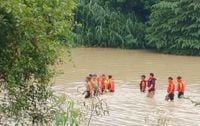In a tragic series of events across Vietnam this week, two separate drownings have brought renewed attention to the dangers posed by natural water bodies, especially during the rainy season and in popular swimming spots. Despite the best efforts of rescue teams, both incidents ended in heartbreak, underscoring persistent challenges in water safety and public awareness.
On October 17, 2025, what started as a routine day for Mr. P.H.T., a cattle herder in Tuy Phuoc commune, Gia Lai province, quickly turned disastrous. According to Dân trí, Mr. P.H.T., aged 48 (though some sources list him as 47), was tending his family's cattle when he noticed one of the animals had strayed across a nearby river. Determined to retrieve it, he plunged into the water, attempting to swim across. But the river, swollen and turbulent from prolonged heavy rains, proved treacherous. As he tried to make his way back, the powerful current swept him away before the eyes of local residents, who immediately alerted authorities.
The incident triggered a swift and comprehensive response. The Firefighting and Rescue Team from Gia Lai province, in coordination with the Tuy Phuoc commune police, mobilized 16 officers and soldiers for a search-and-rescue operation. However, as Pháp Luật Online reported, the conditions were far from ideal. The river was running high and fast, its waters muddy and opaque due to days of rain. To make matters worse, darkness soon fell, further complicating the search and putting rescuers at risk themselves.
Despite these obstacles, the rescue teams persisted through the night. Their efforts finally bore fruit at around 9:10 a.m. on October 18, when Mr. P.H.T.'s body was discovered approximately 800 meters downstream from where he had entered the river, near the Dieu Tri bridge. Authorities promptly handed over his remains to his grieving family, enabling them to begin funeral arrangements. As one local official told Dân trí, "The river water was high, flowing strongly and turbulently due to prolonged heavy rain, causing difficulties for the rescue work."
This somber event was mirrored by another tragedy that unfolded the very next day in Ho Chi Minh City, hundreds of kilometers to the south. On the afternoon of October 18, rescue forces from the city police recovered the body of Đ.H.K., a ninth-grade student, from the depths of a stone lake in the University Village area. The circumstances were heartbreakingly familiar: a day meant for fun with friends turned fatal in an instant.
According to Tủ sách Xã hội, Đ.H.K. and a group of classmates had gone to the lake that morning, a spot known for its scenic beauty but also for its hidden dangers. After some time swimming, one of Đ.H.K.'s friends began to struggle, calling out in panic as he started to drown. Without hesitation, Đ.H.K. swam over to help. He managed to bring his friend to safety at the shore, but the effort left him exhausted. Before anyone could react, Đ.H.K. lost strength, slipped beneath the surface, and disappeared from view.
The alarm was quickly raised, and rescue divers from the Firefighting and Rescue Department were dispatched to the scene. Their search was painstaking and tense, as every minute counted. Ultimately, they succeeded in recovering Đ.H.K.'s body later that day, bringing some closure to his family and friends, though nothing could ease the pain of their loss.
This was not the first time tragedy had struck at the stone lake. In fact, local residents and authorities alike have long recognized the area as a hotspot for drownings. As Tủ sách Xã hội noted, "The stone lake in University Village has had multiple drowning incidents almost every year despite warnings from authorities." Signs and public notices have been posted, and officials have repeatedly cautioned against swimming in the lake, but the warnings often go unheeded, particularly among young people seeking adventure or relief from the heat.
The two drownings, occurring within just 24 hours of each other, have reignited debate about water safety in Vietnam. Many are asking whether enough is being done to educate the public—especially children and rural workers—about the risks posed by rivers and lakes, particularly during the rainy season when water levels rise and currents become unpredictable. Others are calling for more robust preventive measures, such as fencing off dangerous areas, increasing patrols, or even imposing fines for unauthorized swimming.
But the problem is not easily solved. Rivers and lakes are an integral part of rural life in Vietnam, serving as sources of livelihood, recreation, and even transportation. For people like Mr. P.H.T., crossing a river to retrieve lost cattle is a necessity, not a choice. Meanwhile, for urban teenagers like Đ.H.K. and his friends, natural swimming spots offer a rare escape from the pressures of school and city life. As one local resident put it, "Despite repeated warnings, many people still come to swim, leading to heartbreaking incidents."
Authorities in both Gia Lai and Ho Chi Minh City have pledged to review their safety protocols and consider additional measures to prevent future tragedies. In Tuy Phuoc, officials are urging residents to avoid crossing rivers during periods of heavy rain and to seek help if livestock go missing. In Ho Chi Minh City, there are renewed calls for stricter enforcement of swimming bans at dangerous sites, as well as more community outreach to educate young people about water safety.
Yet, as these incidents show, even the best-laid plans can fall short in the face of nature's unpredictability and human impulse. Water, after all, can be both a giver and a taker of life—beautiful and bountiful, but also unforgiving when underestimated.
For the families of Mr. P.H.T. and Đ.H.K., the pain is raw and immediate. For their communities, the losses serve as a stark reminder of the risks that lurk in everyday activities. And for the broader public, these stories underscore the need for vigilance, education, and compassion—qualities that may not prevent every tragedy, but can help ensure that those who are lost are not forgotten.




